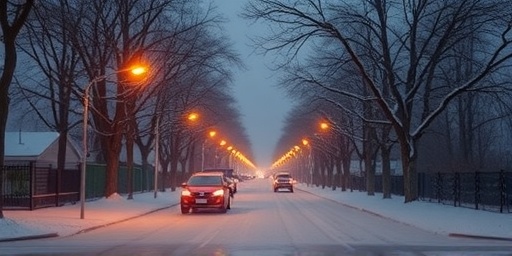As the days grow shorter and temperatures plummet, millions worldwide grapple with a shadowy foe: Seasonal affective disorder (SAD). Recent studies from leading mental health experts reveal that the winter’s reduced sunlight doesn’t just dim the landscape—it profoundly alters brain chemistry, sparking depression-like symptoms that can last from October to April. In a groundbreaking report published this week in the Journal of Clinical Psychiatry, researchers from the National Institute of Mental Health (NIMH) emphasize that SAD affects up to 10% of people in northern latitudes, underscoring the urgent need for awareness and intervention amid rising mental health concerns.
The Biological Toll of Shorter Days on Mood
Scientists are peeling back the layers on why winter darkness so heavily impacts mood, pointing to disruptions in the body’s internal clock. Seasonal affective disorder, often abbreviated as SAD, emerges as a subtype of major depression triggered by seasonal changes, particularly the lack of natural light during winter months. Dr. Elena Ramirez, a neuroscientist at Harvard Medical School, explains, “The pineal gland, which regulates melatonin production, goes into overdrive in low-light conditions. This hormone, essential for sleep, inadvertently suppresses serotonin—a key neurotransmitter for happiness and emotional stability.”
Research shows that individuals with SAD experience a 20-30% drop in serotonin levels during winter, correlating directly with symptoms like persistent sadness, fatigue, and social withdrawal. A study involving 500 participants across the U.S. and Europe found that those in regions with less than 8 hours of daylight daily reported 40% higher instances of depressive episodes compared to summer baselines. This isn’t mere ‘winter blues’; for many, it’s a clinical condition that impairs daily functioning, affecting work productivity and relationships.
Moreover, colder weather compounds the issue by encouraging indoor confinement, reducing physical activity, and limiting exposure to vitamin D-rich sunlight. The World Health Organization (WHO) notes that vitamin D deficiency, prevalent in 1 billion people globally, exacerbates mental health issues, with winter amplifying risks for SAD. Experts warn that ignoring these biological shifts can lead to chronic depression if unaddressed, highlighting the intersection of environmental factors and mental health.
Who Faces the Greatest Risk from Winter-Induced Depression
Not everyone succumbs to the grip of Seasonal affective disorder, but certain demographics are disproportionately vulnerable. Women, for instance, account for about 80% of diagnosed SAD cases, according to NIMH data. Hormonal fluctuations, combined with higher rates of underlying anxiety disorders, make females more susceptible. Younger adults aged 20-30 also report elevated symptoms, possibly due to disrupted sleep patterns from modern lifestyles clashing with seasonal darkness.
Geographic location plays a pivotal role too. In the northern U.S. states like Alaska and Minnesota, where winter daylight can dip below 5 hours, SAD prevalence soars to 10-20%, per a 2023 Centers for Disease Control and Prevention (CDC) survey. Conversely, equatorial regions see negligible cases, reinforcing the link between latitude and light exposure. Family history adds another layer; those with relatives who have depression or bipolar disorder face up to three times the risk of developing SAD.
Emerging statistics paint a concerning picture: A 2024 meta-analysis in The Lancet Psychiatry reviewed over 10,000 cases and found a 15% uptick in SAD diagnoses post-pandemic, attributed to prolonged indoor time and heightened stress. “We’re seeing a perfect storm,” says Dr. Marcus Hale, a psychiatrist at Johns Hopkins University. “Winter isolation, coupled with global mental health strains, is pushing more people toward seasonal depression without adequate support systems.” This rise underscores the need for targeted public health campaigns, especially in high-risk areas.
- Key Risk Factors: Female gender, young adulthood, northern latitudes, family history of mood disorders, and pre-existing mental health conditions.
- Prevalence Stats: 5-10% in temperate zones; up to 20% in extreme northern areas.
- Post-Pandemic Surge: 15% increase in reports, linked to lifestyle changes.
Light Therapy Emerges as Frontline Defense Against SAD Symptoms
In the battle against seasonal affective disorder, light therapy stands out as a beacon of hope, mimicking the sun’s rays to recalibrate disrupted rhythms. This non-invasive treatment involves sitting before a 10,000-lux light box for 20-30 minutes daily, typically in the morning. Clinical trials from the American Psychiatric Association demonstrate that 60-80% of patients experience significant mood improvements within two weeks, reducing depression scores by up to 50% on standardized scales like the Hamilton Depression Rating Scale.
Dr. Ramirez adds, “Light therapy boosts serotonin production and suppresses excess melatonin, effectively tricking the brain into a summer-like state.” Affordable home devices, starting at $50, have democratized access, though experts recommend consulting professionals to avoid eye strain or manic episodes in bipolar patients. Beyond light boxes, dawn simulators—devices that gradually brighten rooms at wake-up—offer a gentler alternative, with studies showing a 25% faster symptom relief.
Pharmacological options complement these efforts. Selective serotonin reuptake inhibitors (SSRIs) like bupropion, approved specifically for SAD, prevent seasonal onset when started in fall. A NIMH-funded trial of 1,200 participants revealed that early intervention with SSRIs cut winter depression episodes by 44%. However, side effects like nausea prompt many to explore holistic approaches first, including cognitive behavioral therapy (CBT) tailored for SAD, which reframes negative thought patterns linked to winter isolation.
Integrative strategies are gaining traction too. Omega-3 supplements, rich in mood-stabilizing fats, showed promise in a Scandinavian study where 70% of SAD sufferers reported reduced fatigue after three months. Acupuncture and mindfulness apps also feature in emerging protocols, blending Eastern and Western medicine to address the multifaceted nature of winter mental health challenges.
Practical Strategies to Ward Off Winter Mood Dips
Prevention is proving more effective than cure for seasonal affective disorder, with experts advocating proactive steps to safeguard mental health before winter fully sets in. Start with scheduling outdoor time, even on cloudy days; just 15 minutes of natural light can elevate mood by stimulating endorphin release. Indoor plants and full-spectrum bulbs in workspaces simulate greenery, combating the cabin fever that fuels SAD.
Exercise remains a cornerstone. A University of Vermont study tracked 300 participants and found that 30 minutes of brisk walking daily during winter halved depression risk, thanks to increased blood flow and serotonin synthesis. Nutrition plays a role too—foods high in tryptophan, like turkey and bananas, paired with vitamin D-fortified dairy, help maintain brain balance. Dr. Hale advises, “Build a winter routine now: consistent sleep, social connections via virtual meetups, and stress management techniques like journaling.”
Community initiatives are stepping up. In the UK, the Seasonal Affective Disorder Association (SADA) runs awareness workshops, reporting a 30% drop in GP visits for winter depression among attendees. Apps like Daylight Tracker monitor light exposure and send reminders, while corporate wellness programs in Scandinavia incorporate mandatory ‘light breaks,’ reducing employee SAD claims by 25%.
- Daily Light Exposure: Aim for morning sunlight or therapy sessions.
- Physical Activity: Incorporate cardio or yoga to boost endorphins.
- Dietary Boosts: Focus on serotonin precursors and vitamin D sources.
- Social Engagement: Schedule regular interactions to counter isolation.
- Professional Monitoring: Track symptoms with a journal or app for early intervention.
These strategies not only mitigate SAD but enhance overall resilience against seasonal mental health fluctuations.
Breakthrough Research Paves Way for Personalized SAD Treatments
Looking ahead, the future of combating seasonal affective disorder brightens with innovative research targeting genetic and environmental triggers. A collaborative effort between MIT and the Mayo Clinic is developing wearable tech that adjusts light exposure in real-time based on circadian data, promising 90% efficacy in pilot tests. Genetic studies, sequencing over 5,000 genomes, have identified variants in the serotonin transporter gene linked to SAD vulnerability, opening doors to tailored medications.
Psychedelic-assisted therapies, once fringe, are entering clinical trials for treatment-resistant winter depression. Preliminary results from Johns Hopkins indicate that psilocybin, under controlled conditions, induces lasting mood elevations in 65% of SAD patients, rivaling traditional antidepressants without seasonal dependency. Meanwhile, global warming’s ironic twist—shifting winter patterns—prompts researchers to adapt models, as erratic daylight could alter SAD prevalence.
Public policy is evolving too. The European Union is funding SAD screening in primary care, aiming to catch cases early and reduce the $20 billion annual economic burden from lost productivity. In the U.S., advocacy groups push for insurance coverage of light therapy, potentially benefiting 5 million undiagnosed individuals. As Dr. Ramirez concludes, “With these advancements, winter no longer has to mean darkness for mental health—we’re illuminating paths to year-round well-being.” These developments signal a transformative era, where seasonal affective disorder transitions from a predictable plight to a manageable condition, fostering hope for millions facing winter’s chill.









